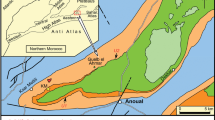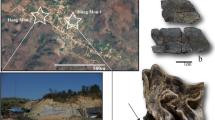Abstract
Both metatherians and eutherians are known from the Early Cretaceous (Barremian, 125 mya; million years ago) of China, while eutherian-dominated mammalian faunas appeared in Asia at least by the earliest Late Cretaceous (Cenomanian, 95 mya). The approximately 99–93 my old (Cenomanian) Sheikhdzheili l.f. from western Uzbekistan is a small sample of only eutherians, including three zhelestids and a possible zalambdalestoid. The much better-known 90 my old (Turonian) Bissekty l.f. at Dzharakuduk in the central Uzbekistan includes 15 named and unnamed species, based on ongoing analyses. Of these, 12 are eutherians represented by at least the three groups—asioryctitheres, zalambdalestids, and zhelestids—plus an eutherian of uncertain position—Paranyctoides. Zalambdalestids and zhelestids have been argued to be related to the origin of the placental gliriforms (Euarchontoglires) and ferungulates (Laurasiatheria), respectively. Although there are four previously recognized metatherians, we believe three are referable to the deltatheroid Sulestes karakshi and the fourth, Sailestes quadrans, may belong to Paranyctoides. There is one multituberculate and one symmetrodont in the Bissekty l.f. While comparably aged (Turonian) localities in North America have somewhat similar non-therians, they have more metatherians and no eutherians. The next younger localities (early Campanian, ∼80 mya) in North America have both a zhelestid and Paranyctoides, suggesting dispersal of eutherians from Asia. At Dzharakuduk, the approximately 85 my old (late Turonian/Coniacian) Aitym l.f. is much less well known than the Bissekty l.f., but yields nearly identical taxa, with two non-therians, one metatherian, and six eutherians.
Similar content being viewed by others
References
Alroy, J. (1999). The fossil record of North American mammals: Evidence for a Paleocene evolutionary radiation. Syst. Biol. 48: 107–118.
Archibald, J. D. (1982). A study of Mammalia and geology across the Cretaceous–Tertiary boundary in Garfield County, Montana. Univ. Calif. Pubs. Geol. Sci. 122: 1–286.
Archibald, J. D. (1996). Fossil evidence for a Late Cretaceous origin of “hoofed” mammals. Science 272: 1150–1153.
Archibald, J. D., and Averianov, A. O. (2001). Paranyctoides and allies from the Late Cretaceous of North America and Asia. Acta Palaeontol. Polonica 46: 533–551.
Archibald, J. D., and Averianov, A. O. (2003). The Late Cretaceous placental mammal Kulbeckia. J. Vertebr. Paleontol. 23: 404–419.
Archibald, J. D., Averianov, A. O., and Ekdale, E. G. (2001). Late Cretaceous relatives of rabbits, rodents, and other extant eutherian mammals. Nature 414: 62–65.
Archibald, J. D., and Deutschman, D. (2001). Quantitative analysis of the timing of origin of extant placental orders. J. Mammal. Evol. 8: 107–124.
Archibald, J. D., Sues, H.-D., Averianov, A. O., King, C., Ward, D. J., Tsaruk, O. A., Danilov, I. G., Rezvyi, A. S., Veretennikov, B. G., and Khodjaev, A. (1998). Précis of the paleontology, biostratigraphy, and sedimentology at Dzharakuduk (Turonian? - Santonian), Kyzylkum Desert, Uzbekistan. In: Lower to Middle Cretaceous Terrestrial Ecosystems, J. I. Kirkland and S. Lucas, eds., N. M. Mus. Nat. Hist. Sci. Bull. 14: 21–28.
Averianov, A. O. (1999). A new species of multituberculate mammal Uzbekbaatar from the Late Cretaceous of Uzbekistan. Acta Palaeontol. Polonica 44: 301–304.
Averianov, A. O., and Archibald, J. D. (2003). Mammals from the Upper Cretaceous Aitym Formation, Kyzylkum Desert, Uzbekistan. Cret. Res. 24: 171–191.
Averianov, A. O., and Archibald, J. D. (2005). Mammals from the mid-Cretaceous Khodzhakul Formation, Kyzylkum Desert, Uzbekistan. Cret. Res. 26: 593–608.
Averianov, A. O., and Kielan-Jaworowska, Z. (1999). Marsupials from the Late Cretaceous of Uzbekistan. Acta Palaeontol. Polonica 44: 71–81.
Cifelli, R. L. (1990a). Cretaceous mammals of southern Utah. III. Therian mammals from the Turonian (early Late Cretaceous). J. Vertebr. Paleontol. 10: 332–345.
Cifelli, R. L. (1990b). Cretaceous mammals of southern Utah. IV. Eutherian mammals from the Wahweap (Aquilan) and Kaiparowits (Judithian) formations. J. Vertebr. Paleontol. 10: 346–360.
Cifelli, R. L. (1993). Early Cretaceous mammal from North America and the evolution of marsupial dental characters. Proc. Natl. Acad. Sci. U.S.A. 90: 9413–9416.
Cifelli, R. L. (1997). First notice on Mesozoic mammals from Oklahoma. Okla. Geol. Notes, Okla. Geol. Surv. 57: 4–17.
Cifelli, R. L., and Madsen, S. K. (1999). Spalacotheriid symmetrodonts (Mammalia) from the medial Cretaceous (upper Albian or lower Cenomanian) Mussentuchit local fauna, Cedar Mountain Formation, Utah, USA. Geodiversitas 21: 167–214.
Cifelli, R. L., and Muizon, C. de (1997). Dentition and jaw of Kokopellia juddi, a primitive marsupial or near-marsupial from the medial Cretaceous of Utah. J. Mammal. Evol. 4: 241–258.
Clemens, W. A., Lillegraven, J. A., Lindsay, E. H., and Simpson, G. G. (1979). Where, when, and what—A survey of known Mesozoic mammal distribution. In: Mesozoic Mammals: The First Two-thirds of Mammalian History, J. A. Lillegraven, Z. Kielan-Jaworowska, and W. A. Clemens, eds., pp. 7–58, University of California Press, Berkeley.
Eaton, J. G. (1993). Therian mammals from the Cenomanian (Upper Cretaceous) Dakota Formation, Southwestern Utah. J. Vertebr. Paleontol. 13: 105–124.
Eaton, J. G. (1995). Cenomanian and Turonian (early Late Cretaceous) multituberculate mammals from southwestern Utah. J. Vertebr. Paleontol. 15: 761–784.
Eaton, J. G., and Cifelli, R. L. (2001). Multituberculate mammals from near the Early–Late Cretaceous boundary, Cedar Mountain Formation, Utah. Acta Palaeontol. Polonica 46: 453–518.
Ekdale, E. G., Archibald, J. D., Averianov, A. O. (2004). Petrosal bones of placental mammals from the Late Cretaceous Uzbekistan. Acta Palaeont. Polonica 49: 161–176.
Flynn, J. J., and Wyss, A. R. (1998). Recent advances in South American mammalian paleontology. Trends Ecol. Evol. 13: 449–454.
Fox, R. C. (1984). Paranyctoides maleficus (new species), an early eutherian mammal from the Cretaceous of Alberta. Carnegie Mus. Nat. Hist. Sp. Publ. 9: 9–20.
Ji, Q., Luo, Z., Yuan, C., Wible, J. R., Zhang, J., and Georgi, J. A. (2002). The earliest known eutherian mammal. Nature 416: 816–822.
Kielan-Jaworowska, Z. (1981). Evolution of the therian mammals in the Late Cretaceous of Asia. Part IV. Skull structure in Kennalestes and Asioryctes. Palaeontol. Polonica 42: 25–78.
Kielan-Jaworowska, Z., and Nessov, L. A. (1992). Multituberculate mammals from the Cretaceous of Uzbekistan. Acta Palaeontol. Polonica 37: 1–17.
King, C., Morris, N. J., Ward, D. J., and Hampton, M. J. (in press). Late cretaceous strafigraphy of the central and western Kyzylkum Desert, Uzbekistan. Cret. Res.
Krause, D. W., Kielan-Jaworowska, Z., and Turnbull, W. D. (1990). Early Cretaceous Multituberculata (Mammalia) from the Antlers Formation, Trinity Group, of southcentral Texas. J. Vertebr. Paleontol. 10: 31A.
Lillegraven, J. A. (1969). Latest Cretaceous mammals of upper part of Edmonton Formation of Alberta, Canada, and review of marsupial–placental dichotomy in mammalian evolution. Univ. Kansas Paleontol. Contrib. 50: 1–122.
Luo, Z., Ji, Q., Wible, J. R., and Yuan, C. (2003). An early Cretaceous tribosphenic mammal and metatherian evolution. Science 302: 1934–1940.
McKenna, M. C., Kielan-Jaworowska, Z., and Meng, J. (2000). Earliest eutherian mammal skull, from the Late Cretaceous (Coniacian) of Uzbekistan. Acta Palaeontol. Polonica 45: 1–54.
Meng, J., Hu, Y., and Li, C. (2003). The osteology of Rhombomylus (Mammalia, Glires): Implications for phylogeny and evolution of Glires. Bull. Am. Mus. Nat. Hist. 275: 1–247.
Nessov, L. A. (1982). Ancient mammals of the USSR [in Russian]. Ezh. Vses. Paleontol 25: 228–242.
Nessov, L. A. (1985a). New mammals from the Cretaceous of the Kyzylkum Desert [in Russian]. Vestn. Leningradsk. Univ. Ser. 7 17: 8–18.
Nessov, L. A. (1985b). Rare bony fish, terrestrial lizards and mammals of the zone of estuaries and coastal plains of the Cretaceous Kyzylkum Desert [in Russian]. Ezh. Vses. Paleontol. Obsh. 24: 199–218.
Nessov, L. A. (1993). New Mesozoic mammals of middle Asia and Kazakhstan and comments about evolution of theriofaunas of Cretaceous coastal plains of Asia [In Russian with English summary]. Trudy Zool. Inst. Ross. Akad. Nauk 249: 105–133.
Nessov, L. A. (1997). Cretaceous Non-marine Vertebrates of Northern Eurasia. [In Russian with English summary], University of Saint Petersburg, Institute of the Earth Crust, Saint Petersburg. (Posthumous edition by L. B. Golovneva and A. O. Averianov).
Nessov, L. A., Archibald, J. D., and Kielan-Jaworowska, Z. (1998). Ungulate-like mammals from the Late Cretaceous of Uzbekistan and a phylogenetic analysis of Ungulatomorpha. In: Dawn of the Age of Mammals in Asia, C. K. Beard and M. R. Dawson, eds., Bull. Carnegie Mus. Nat. Hist. 34: 40–88.
Novacek, M. J., Rougier, G. W., Wible, J. R., McKenna, M. C., Dashzeveg, D., and Horovitz, I. (1997). Epipubic bones in eutherian mammals from the Late Cretaceous of Mongolia. Nature 389: 483–486.
Schuyler, E. (1876). Turkistan: Notes of a Journey in Russian Turkistan, Khokand, Bukhara, and Kuldja. Two volumes. 4th ed. Sampson Low, Marston, Searle, & Rivington, London.
Szalay, F. S., Sargis, E. J., Archibald, J. D., and Averianov, A. O. (2003). Late Cretaceous therian postcranials from the Kyzylkum Desert, Uzbekistan: A preliminary assessmnet of taxonomic properties. J. Vertebr. Paleontol. 23: 103A.
Tsubamoto, T., Rougier, G. W., Isaji, M., Manabe, M., and Forasiepi, A. M. (2004). New Early Cretaceous spalacotheriid “symmetrodont” mammal from Japan. Acta Palaeontol. Polonica. 49: 329–346.
Wible, J. R., Novacek, M. J., and Rougier, G. W. (2004). New data on the skull and dentition in the Mongolian Late Cretaceous eutherian mammal Zalambdalestes. Bull. Am. Mus. Nat. Hist. 281: 1–144.
Author information
Authors and Affiliations
Corresponding author
Rights and permissions
About this article
Cite this article
Archibald, J.D., Averianov, A.P. Mammalian Faunal Succession in the Cretaceous of the Kyzylkum Desert. J Mammal Evol 12, 9–22 (2005). https://doi.org/10.1007/s10914-005-4867-3
Issue Date:
DOI: https://doi.org/10.1007/s10914-005-4867-3




